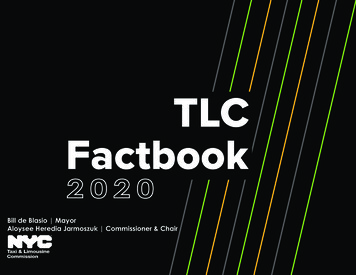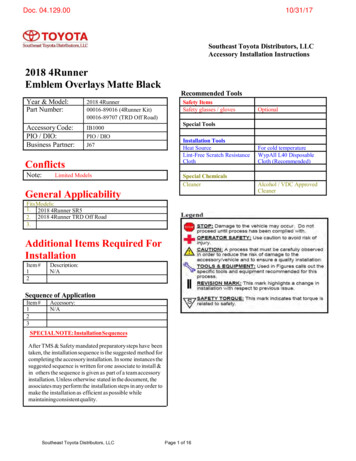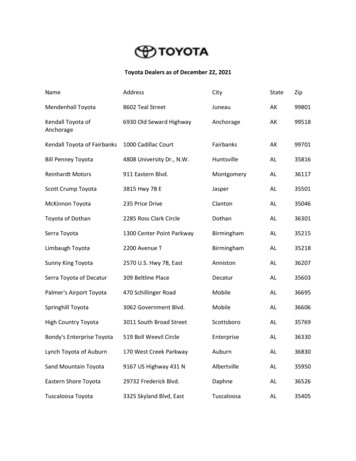
Transcription
ISSN: 1650-8319, UPTEC STS08032Examensarbete 30 hpNovember 2008Strategic Business Intelligenceat Toyota Material Handling EuropeJon-Erik OlssonJimmy Sandell
AbstractStrategic Business Intelligence at Toyota MaterialHandling EuropeJon-Erik Olsson & Jimmy SandellTeknisk- naturvetenskaplig orietLägerhyddsvägen 1Hus 4, Plan 0Postadress:Box 536751 21 UppsalaTelefon:018 – 471 30 03Telefax:018 – 471 30 00Hemsida:http://www.teknat.uu.se/studentBusiness Intelligence (BI) is as an academic subject a rather unexplored research fieldand within the business context, BI leads an ambivalent existence. BI is foremost usedeither as a term capturing other intelligence terms or as a denotation fordecision-support systems. Within this Master Thesis, BI is therefore approached as anumbrella concept covering both these offshoots. The Thesis is centered on a CaseStudy conducted at Toyota Material Handling Europe (TMHE) and the initiatedprocess of defining and enhancing Strategic Business Intelligence. TMHE has dividedtheir BI in Strategic and Operative BI, where the latter has been in focus historically.The Case Study indicates that it is neither pragmatic nor illustrational to define BI asan umbrella concept and that BI is too complex to be described only in onedimension (i.e. in Strategic and Operative). A new structure is proposed in which BI isdescribed with three frameworks (Activities, Categories, and Processes); in order tobetter capture the complexity of the subject. As a way to improve the BI work withinTMHE, an information needs analysis was conducted among the top and middlemanagement using a modification of the World Mapping Method. The outcome of theanalysis was suggestions of potential areas for coordination of information needs. Toimprove issues of handling of unstructured information within TMHE, there is a needfor change of the organizational culture. The concepts of Wiki, RSS, and EnterpriseSearch, all connected to Enterprise 2.0, are seen as tools that could help theorganization.KeywordsBusiness Intelligence, BI, Strategic Business Intelligence, Operative BusinessIntelligence, Information Needs Analysis, Unstructured Information, World MappingMethod, Information Handling, Enterprise 2.0, Wiki, RSS, Enterprise Search, ToyotaMaterial HandlingHandledare: Peter HyltbergÄmnesgranskare: Roland N. BolExaminator: Elísabet AndresdóttirISSN: 1650-8319, UPTEC STS08032Sponsor: Toyota Material Handling EuropeTryckt av: Institutionen för informationsteknologi, Uppsala Universitet
AcknowledgementsA long journey has come to an end. Now it is time to thank those who guided our way.First of all, our project sponsor Daniel Ellison, for your curiosity and will to let uspursue this project - a project that wouldn’t have been possible without our supervisor,Peter Hyltberg. Thank you for your 24-7 support and problem-solving attitude! Wewould also like to give prominence to our Steering Group at TMHE for helping us stayon track, and to our supervisor and reviewer at Uppsala University, Roland N. Bol, foryour encouragement and indulgence.A special thanks is sent to Magnus Hoppe, for the enthusiasm with which you haveprovided invaluable feedback and input to our work. Finally we would like to showgratitude towards our respondents at TMHE, who have given of their scarce time andtaken part of this project.Thank You All.Stockholm, October 2008Jon-Erik Olsson & Jimmy Sandell
Executive SummaryBusiness Intelligence (BI) is as an academic subject a rather unexplored research field,and within a business context, BI leads an ambivalent existence. BI is foremost usedeither as a term capturing other intelligence terms or as a denotation for decisionsupport systems. Within this Master Thesis, BI is therefore approached as an umbrellaconcept covering both these offshoots. The Thesis is centered on a Case Studyconducted at Toyota Material Handling Europe (TMHE) and the initiated process ofdefining and enhancing Strategic Business Intelligence. TMHE has divided BI inStrategic and Operative BI, where the latter has been in focus historically.The Case Study indicates that it is neither pragmatic nor illustrational to define BI as anumbrella concept and that BI is too complex to be described only in one dimension (e.g.in Strategic and Operative). Therefore we propose a new structure in which BI isdescribed by three frameworks (Categories, Activities, and Processes), in order to bettercapture the complexity of the subject. The Case Study also evidently shows that thedivision of BI in Strategic and Operative lacks clarity and meaning within the company.The categories framework provides a way to recognize all activities performed in thecompany that could be labeled as intelligence work, and we recommend dividing the BIwork in the four categories: Market Intelligence, Competitive Intelligence, MacroIntelligence, and Internal Intelligence. We believe that this division will lead to a betteroverview and acknowledgment of the work done, something we found necessary due tothe company’s functional structure and lack of transparency.The duality of work methods separates continuously intelligence work within thecorporate functions, from ad hoc and sometimes cross-functional studies performed bydifferent groups. The latter is also an additional ambition for Strategic BI and thereforeexpected to have a more prominent role in the future, which is why the need fordifferentiating the way of working increases. By applying the framework of activitieswe see that this will help TMHE to relate to BI work as well as a way to confront thefound anxiety among our respondents of BI as either tools and applications or assomething solely for the TMHE Management Team.We mean that a run-through of the existing BI work within the organization isnecessary, which is to be performed within the framework of processes. We do notbelieve in, and have not found appropriate theoretical support for, one general BIprocess. Instead the processes ought to be based on the activities performed todaylocally in the corporate functions, and to be evaluated from the point of view of what BIis to support. Questions that need to be addressed are: who is to do the work, when is itto be done, what is to be the output, and in what format (e.g. reports, work shops orpresentations)? We recommend the use of firm deliverables; meaning, in accordancewith the discussion above, standardized intelligence products tailored to suit the targetaudience.
As a way to improve the BI work within TMHE, we conducted an information needsanalysis among the top and middle management of central functions using amodification of the World Mapping Method. The information needs were categorized inthe different categories proposed in our model above, and the outcome of the analysiswas suggestions of potential areas for coordination of information needs. The mostevident categories of information needs with an unsatisfied information supply todaycan all be referred to the category Macro Intelligence. We thus recommend BusinessPlanning Department to investigate how these information needs ought to be suppliedand we also see this finding as a support to our structure. However, foremost we see thatthe information needs analysis is to be used as a basis for discussion with a twofoldapplicability: firstly as a highlighter of information gaps, and secondly as a highlighterof areas of improvements from the perspective of information handling.Finding and gathering of information is today dominated by interaction within thepersonal network, which is an effective but time consuming strategy. For example,information on issues that has not been touched upon before is perceived to be difficultto find. This is partly due to the complex structure of the intranet, which results in that itserves more as a location drop than as a natural source of information.We see that the new BI structure would increase the transparency in the organization,however, in order for this to happen we see it as a necessity that the output of the BIstructure is made available to the rest of the organization (to the extent that this ispossible). In order to reach an effective information handling, we also see the need forpeople taking power of their own information supply. This is because one cannot knowall information needs of another person, and because this strategy ensures thatinformation is gathered in a time and location that suits the user. To improve issues ofhandling of unstructured information within TMHE, there is a need for change of theorganizational culture. The concepts of Wiki, RSS, and Enterprise Search, all connectedto the buzzword Enterprise 2.0, are seen as tools that could help the organization both tofacilitate BI work and to enhance information handling.Wikis provide a tool, but maybe more important a different way of working, aiming atimproving collaboration, information sharing, and creativity among its users. Theprimary area for use would be as a digital notebook, where information and files couldbe structured and shared with others, enabling the creation of a common view ofinformation in a living document. We see that Wikis would be especially useful for anyteam our group within TMHE, but especially useful for BI groups that handle a lot ofunstructured information. We see that the use of an RSS tool will provide good supportfor monitoring changes and adding of information on the intranet and Internet in generaland in BI areas as Competitive and Macro Intelligence in particular. Thus it is possibleto avoid having to manually track the changes of information sources. Enterprise Searchplatforms provide a powerful tool for finding unstructured information located indifferent information systems in an organization. Through the use of a contextual searchengine, the search result will be custom tailored to suit the intentions and the profile ofthe user. We see that this tool could help to overcome the issues experienced when notbeing able to find information on the intranet because of its complex structure.
Populärvetenskaplig beskrivningBusiness Intelligence (BI) är ett ämne som väcker känslor i de flesta läger. Antingen föratt man saknar någon egentlig relation till begreppet, trots att det känns välbekant, elleratt den relation man har inte stämmer överens med hur begreppet används. Denvanligaste definitionen är BI som någon form av beslutsstöd, kanske som teknisklösning eller som omvärldsbevakning. BI har en tydlig koppling till militär användningav termen (jfr underrättelsetjänst), samt leverantörer av olika applikationer förbeslutstöd. Idag är det en vanligt förekommande funktion eller tjänst inom de flestastörre företag. Vi har med det här examensarbetet närmat oss ämnet genom en fallstudieutförd hos Toyota Material Handling Europe (TMHE), som är en del i en ambition attutveckla företagets strategiska BI. TMHE har delat upp sin BI i operativ och strategisk,där den förstnämnda syftar mer till en beskrivning av BI som tekniska systemlösningar.Fokus inom TMHE har tidigare varit inriktat mot vad som i uppdelningen benämnsoperativ BI, således har man sett behov att stärka upp den strategiska delen.Vi har därför dels undersökt hur BI-arbetet ser ut inom TMHE idag, samt synatuppdelningen i operativ och strategisk i sömmarna i och med de ovan nämnaoklarheterna, som ofta omhuldar detta ämne. Vi har även genomfört eninformationsbehovsanalys med utgångspunkt i Per Frankelius World Mapping Method,bland top- och middle management på företaget. Analysen skedde främst för att hittainom vilka områden företaget saknar eller har en svag informationsförsörjning idag,samt för att hitta förbättringsområden utifrån ett koordineringsperspektiv.Specifikt för strategisk information är att den ofta finns ostrukturerad inom eller utanförföretaget, varför hantering av denna information är av stort intresse för dem som jobbarmed BI. Vi har på grund av detta även studerat hur informationshanteringen ser ut idaginom TMHE med syftet att kravställa hjälpmedel som skulle kunna underlätta dettaarbete.Undersökningens resultat pekar på att uppdelningen i operativ och strategisk inte är enfördelaktig uppdelning, dels eftersom begreppen i sig är svåra att definiera och dels föratt en enda dimension visat sig vara för fattigt för att göra begreppet rättvisa. Vi hardärför tagit fram en modell som genom tre olika perspektiv (aktivitets-, kategori- ochprocessbaserat) bättre kan beskriva detta komplexa begrepp. Vi har även tittat på hurdetta skulle kunna struktureras inom TMHE, samt placerat in de informationsbehov vifunnit i behovsanalysen inom våra föreslagna kategorier. Vi har även genom analysenkunna peka på områden som behöver höjd beredskap utifrån våra respondentersönskemål.Vi presenterar även tre förslag på lösningar som skulle underlätta hanteringen avostrukturerad information inom TMHE. Dessa är alla knutna till begreppet Enterprise2.0 (jfr Web 2.0) som koncept som alla har gemensamt att användaren sitter i förarsätetoch att interaktivitet och samarbete främjas. Vi föreslår att TMHE bör överväga att iframtiden använda sig av Wikis, RSS samt att implementera en Enterprise Searchplattform.
Table of Contents1 Introduction . 15 1.1 Background . 15 1.2 Problem Description . 15 1.3 Purpose. 16 1.3.1 Discussion of Purpose. 16 1.3.2 Research Questions . 16 1.3.3 Delimitations . 17 1.4 Thesis Outline . 18 2 Company Presentation . 21 2.1 Toyota Industries Corporation and BT Industries . 21 2.2 Toyota Material Handling Europe (TMHE) . 21 2.3 TMHE Business Planning . 22 2.4 TMHE IS/IT Organization. 22 2.4.1 IS Promotion . 22 2.5 Business Intelligence at TMHE . 23 3 Theoretical Framework . 25 3.1 Business Intelligence . 25 3.1.1 Intelligence Terminology . 25 3.1.2 Business Intelligence as a Managerial Support . 27 3.1.3 Umbrella Concept. 29 3.1.4 Business Intelligence as Activities in a Process . 30 3.1.5 The Importance of Having a Common View of the BI Work . 33 3.1.6 Business Intelligence and Strategy Work. 33 3.1.7 Different Frameworks for Structuring BI – A Case Example . 35 3.2 Information Needs Analysis . 38 3.2.1 Information Needs and Information Wants. 38 3.2.2 Methods for Capturing Information Needs . 39 3.2.3 Filling the Intelligence Gaps . 44 3.3 Information Handling. 45 3.3.1 The Importance of Personal Networks . 45 3.3.2 Information Sharing versus Information Hoarding . 45 3.3.3 Should Information be Pushed or Pulled?. 45 3.3.4 A Change from Centralization to Decentralization . 46 3.3.5 When Change Meets Resistance . 48 3.4 Systems Support for Handling Unstructured Information . 50 3.4.1 Web 2.0 becomes Enterprise 2.0 . 50 3.4.2 Wikis . 52 3.4.3 Signaling through RSS Feeds . 55 3.4.4 Enterprise Search Platforms . 55 3.4.5 Implementing Enterprise 2.0 . 60 3.5 Practical Use of Chosen Theory . 64 3.5.1 Business Intelligence Theory . 64 3.5.2 A New Model . 64 3.5.3 Information Needs Analysis . 66 3.5.4 Information Handling . 66 4 Method . 67 4.1 Scientific Approach . 67 4.2 Qualitative and Quantitative Research . 68 4.3 Case Study . 68 4.4 Course of Action . 70 4.5 Data Collection . 70 4.5.1 Primary and Secondary Data . 70 11
4.5.2 Literary pre-study . 71 4.5.3 Literature Study . 71 4.5.4 Interviews . 71 4.5.5 TMHE Respondents . 73 4.5.6 Information Needs Analysis . 74 4.6 Critique of Chosen Method . 79 4.6.1 Case Studies . 79 4.6.2 Qualitative Research – The Interview Situation . 80 4.6.3 Reliability and Validity . 80 4.6.4 The Presented Methods for the Needs Analysis. 81 5 Case Study. 83 5.1 Current Situation within TMHE . 83 5.1.1 Issues of Merging Two Companies . 83 5.1.2 TMHE – A Company with a Functional Structure . 84 5.1.3 Different Cultures Working Together . 85 5.1.4 Increased Focus on Strategic Work . 86 5.2 The Assigned BI Actors within TMHE . 89 5.2.1 The Role of Business Planning . 89 5.2.2 IS Promotion – A Gatherer of Needs . 90 5.3 Respondents’ Views on Business Intelligence . 93 5.3.1 What is Business Intelligence? . 93 5.3.2 Keeping the Core Knowledge Local . 94 5.3.3 A Business Intelligence Function . 94 5.3.4 Lacking Areas within Business Intelligence . 94 5.4 Business Intelligence within TMHE . 96 5.4.1 History of Business Intelligence within TMHE . 96 5.4.2 Respondents Views on Strategic and Operative BI . 97 5.4.3 Intelligence Work within TMHE . 100 5.4.4 Another Ambition for Strategic BI . 102 5.5 Information Needs Analysis – Result of the Questionnaire . 104 5.5.1 Varying Supply of Information . 104 5.5.2 Background and Overall Outcome . 104 5.5.3 The Results in the Form of Two Lists. 105 5.6 Information Handling. 107 5.6.1 Unstructured Information . 107 5.6.2 Finding and Gathering of Information. 108 5.6.3 Information Sharing . 110 6 Analysis . 115 6.1 Business Intelligence at TMHE . 115 6.1.1 The Assigned BI Actors within TMHE . 115 6.1.2 Business Intelligence at TMHE . 117 6.1.3 Re-Thinking the Division – A New Model . 122 6.1.4 Applying the Model . 125 6.2 Information Needs Analysis . 129 6.2.1 Shift of Focal Area . 129 6.2.2 Filling of the Gaps . 129 6.2.3 Finding the Actual Information Needs . 129 6.2.4 List of Information Gaps . 130 6.2.5 Filtered List of Information Gaps . 130 6.2.6 Cautious Interpreting of the Results . 130 6.2.7 Coordination of Information Needs . 131 6.3 Information Handling. 133 6.3.1 Unstructured Information, Business Intelligence, and Information Handling . 133 6.3.2 Issues of Information Handling . 133 6.3.3 Information Handling and the New BI Structure . 138 6.3.4 Systems Solutions for Handling Unstructured Information . 139 12
7 Conclusions . 145 7.1 Business Intelligence . 145 7.1.1 Assigned BI Actors and Division . 145 7.1.2 Intelligence Work Not Labeled as Intelligence . 145 7.1.3 The Need for more than One Dimension to Describe BI . 145 7.1.4 Additional Frameworks . 145 7.1.5 New Assigned BI Actors . 146 7.2 Information Needs Analysis . 146 7.2.1 Information Gaps . 146 7.2.2 Areas of Coordination. 146 7.2.3 Need for Macro Intelligence . 147 7.2.4 Information Needs Analysis as a Catalyst for Discussion . 147 7.3 Information Handling. 147 7.3.1 Information Finding and Gathering. 147 7.3.2 Information Sharing . 148 7.3.3 Issues Rooted in Organizational Culture. 148 7.3.4 Wikis . 148 7.3.5 RSS . 149 7.3.6 Enterprise Search. 149 8 Recommendations and Next Steps . 151 8.1 Recommendations . 151 8.1.1 Business Intelligence within TMHE . 151 8.1.2 Strategic Business Intelligence . 152 8.1.3 Information Handling . 152 8.2 Next Steps . 154 References . 155 Glossary . 161 Appendix 1 . 163 Appendix 2 .
for change of the organizational culture. The concepts of Wiki, RSS, and Enterprise Search, all connected to Enterprise 2.0, are seen as tools that could help the organization. Keywords Business Intelligence, BI, Strategic Business Intelligence, Operative Business Intelligence, Information Needs Analysis, Unstructured Information, World Mapping










